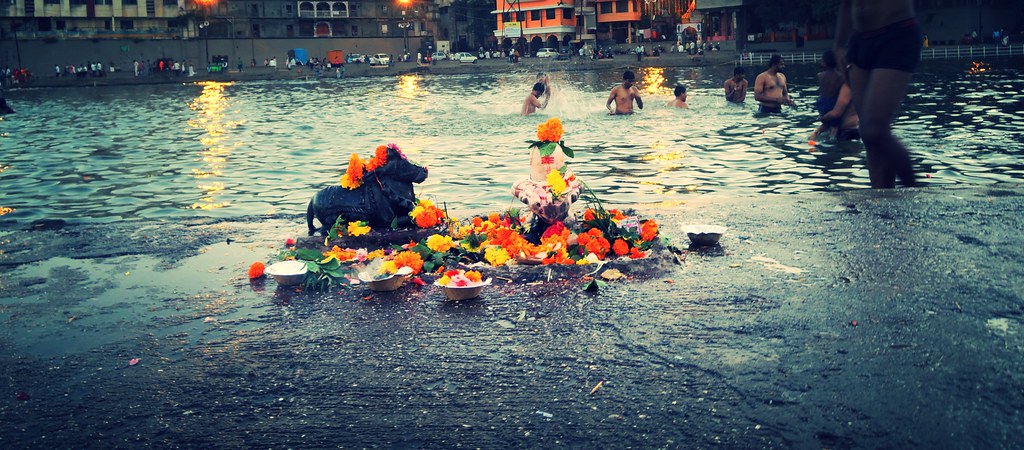NASHIK — In western India, a giant city is disappearing after just two months in existence. During August and September, Nashik received 30 million pilgrims, 10 times its population, during the Hindu Kumbh Mela pilgrimage. Temporary hospitals, houses, police stations and latrines were built for the occasion. Exceptional logistics were developed to transport water and food and to guarantee the security of the worshippers. But almost all this infrastructure has disappeared, as Nashik returns from being an ephemeral megalopolis to, once again, a city of three million residents.
This accelerated urbanization phenomenon is instructive to an India that is expected to count 500 million new residents in its cities by 2050. "If a temporary city of several million residents can be erected and administrated, why not apply the same efficient planning methods to other urban contexts?" says Rahul Mehrotra, an urbanism professor at Harvard University. "Kumbh Mela is an extreme case of urbanism, and analyzing extremes can be very productive."
Kumbh Mela has become a laboratory for urbanism, where technological innovations are tested. The Massachusetts Institute of Technology (MIT) has even organized "innovation camps," or "Kumbhatons," in Nashik to detect and develop technologies in fields as varied as epidemics, mobility, crowd control and housing.
"There are only smart cities if there are smart citizens who have smart technological solutions at their disposal," explains the MIT Media Lab's Margaret Church.
"Global city"
Organizers of the innovation camps received about 1,000 proposals, of which 200 were selected and 10 were tested this year. One of the technologies makes it possible to automatically count crowds thanks to a mattress covered in sensors. Another can map population densities in real time thanks to data analysis of the relay masts of telecommunications operators. The goal is to imagine solutions to help pilgrims find their way in this new place that, with 17 spoken languages, looks almost like a "global city." The engineers developed 3D maps and, most importantly, favored icons over language.
The largest Kumbh Mela pilgrimage was in February 2013, between the Ganges and the Yamuna rivers, in northern India. One hundred million pilgrims traveled there during the two-month festival to bathe in the sacred water. A team of about 50 Harvard researchers made the trip to try and understand this temporary urbanization phenomenon, a bit like how someone would study a beehive. The management researchers went to question the street vendors to understand how they managed the "risks and uncertainty" in an improvised economy, or how a supply chain could be created so rapidly.
Others tried to develop solutions to manage the reception capacities of hospitals and the real-time monitoring of epidemics. "If a solution works during the Kumbh Melah, where there are so many unpredictable elements, then it can work anywhere else," explains Satchit Balsari, a professor at Cornell University's Weill Medical College. Researchers equipped with tablets went to health centers to take information about the number of patients and diagnostics and to warn authorities in real-time about the risks of epidemics.
Several urbanists, led by Rahul Mehrotra, wanted to understand how a temporary city could work so well, and they wanted to draw valuable lessons for the rest of the country. In India, urban planning often comes too late, like an adjustment variable for unimpeded growth. "Today, buildings are designed to last as long as possible. They don't take into account the possible transformations they may go through," the Harvard researchers write in their book Kumbh Mela: Mapping the Ephemeral Mega City.
Recycling
The ephemeral aspect of a city depends on the construction material and the governance methods used. For Kumbh Mela, the tents are built with long pieces of bamboo tied to each other and covered with a fabric. They are economical and easy to carry, and only the assembling will distinguish a temple from a hospital or a police station. At the end of the festival, everything is recycled. The pipes are sent to other construction sites, and tents are used elsewhere — for instance, in wedding ceremonies. Farmers replant their harvests at the same place where tens of thousands of pilgrims gathered. "The most revolutionary opportunity to redefine the way we produce habitable space is maybe in low technological intensity strategies," the Harvard researchers say.
Because with more and more complex construction processes, villages freeze. The management of an ephemeral city must also be flexible. During the festival's organization, the barriers between the different administrations disappeared. The rigidity and hierarchies of the Indian bureaucracy vanished. Government workers from about 25 different administrations worked together on the ground. "This way, administrators can handle any mishaps rapidly and efficiently, without going through ineffective authorization procedures," Mehrotra says.
The future of urbanism in India can perhaps be seen in the most ancient and largest Hindu pilgrimage in the world. The organizers of other pilgrimages could also learn a lot from this.







